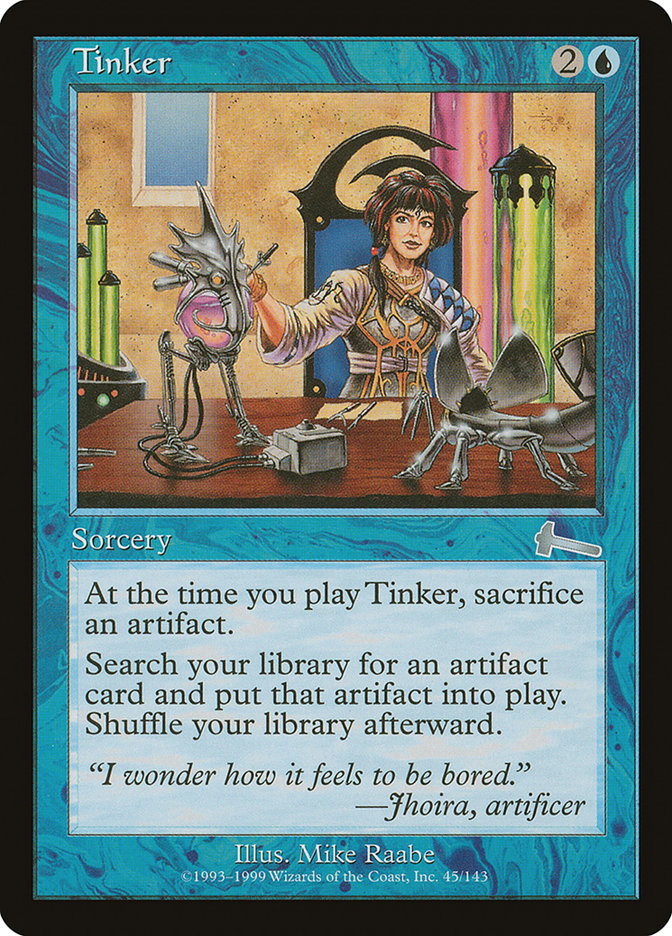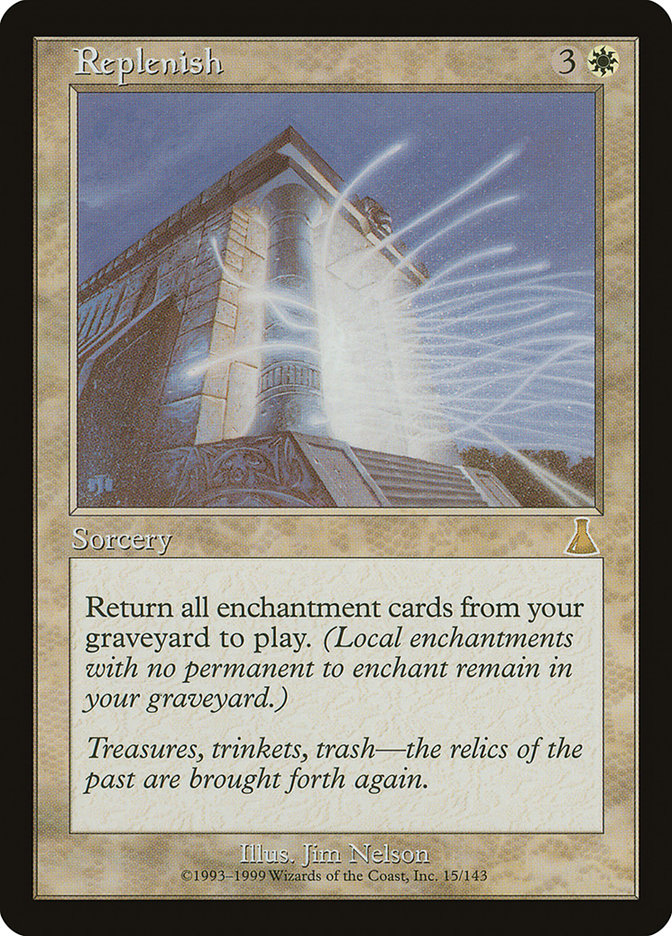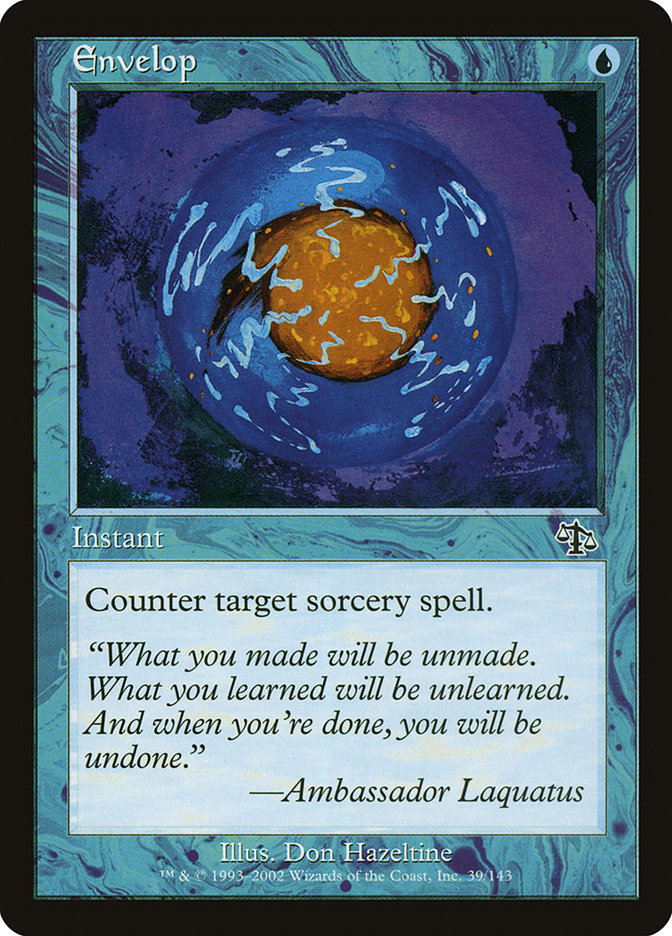
By the time you are reading this, the 2015 World Championships at PAX will have already begun. Sadly this marks the second year in a row that my results weren’t good enough to make the cut, but I’m okay with that. I’ve had many opportunities to play at Magic’s World Championships, some in the new smaller format and other when the event was more akin to a traditional Pro Tour except with more rounds, more formats, and a different road to qualification.
The latest incarnation of the World Championship is by far my favorite. With a smaller field made up of only the most successful players from the last Pro Tour season, every match is worthy of a feature match. Emerging from that field as the winner is truly a feat worthy of being called a World Champion. I love the atmosphere of camaraderie and respect between every player, even when they sit down across the table from one another. It’s my favorite tournament to play, and I hope to make it back again someday.
But today, while players sit down in Seattle to duke it out for the right to be called World Champion, I want to look back at the prior World Championships I played in and talk about what I learned from each of them.
My first World Championship was in Brussels back in 2000. I had managed to qualify for the event based on my rating (back when such a thing was still possible) due to a string of excellent finishes in PTQ events during my freshman year in college. What can I say – I guess the curriculum just wasn’t challenging enough for me.
Thanks to the friends I’d made during my prior stint on the Pro Tour while I was in high school, I managed to land with an excellent playtesting group for the event. Things were quite a bit looser back then as far as teams were concerned, and playtest groups were largely just made up of whoever’s friends happened to be qualified. Thankfully, my friends included such luminaries as Ben Rubin, Jon Finkel, and the O’Mahoney-Schwartz brothers.
Back then, major events weren’t synched up to the release schedule of sets like they are today, so there was a lot more information available about what to expect in a given format. A Mono-Blue Tinker deck had performed well at Nationals over the summer, but most people felt it wasn’t competitive due to a poor matchup against Replenish, which was one of the most powerful and popular decks at the time. Even against a great draw that put an early Mishra’s Helix onto the battlefield to lock down its mana, Replenish could always float mana and Frantic Search to untap its lands and then cast a big Replenish to bringing back cards like Seal of Cleansing to make the Tinker deck’s life miserable.
I refused to give up so easily though. I played the Tinker against Replenish matchup with Dan OMS countless times, experimenting with different sideboard plans in order to find one that could work. Ultimately we combined Annul, Miscalculation, and Rising Waters to transform into a full on Counter-Prison style of deck against Replenish. The countermagic helped keep the Replenish deck from being able to go off in small windows of opportunity, and Rising Waters was the nail in the coffin that prevented them from ever being able to get out of the Mishra’s Helix lock – even with Frantic Search.
My personal result at the 2000 World Championship was just a Top 64 finish, but Jon Finkel and Bob Maher went on the meet in a mirror match finals playing the very Tinker deck I had worked so hard to tune.
The Lesson: Don’t give in to common wisdom. There’s usually a way to win any matchup if you’re willing to sacrifice enough, and sometimes that sacrifice is worth it.
2001 – Toronto (100th)
Worlds in 2001 in Toronto was my first World Championship when I really considered myself a pro. I had made my first Top Eight in Chicago in 2000 playing my Red Zone deck with which I famously won multiple key matches by putting Armadillo Cloak on Rith the Awakener, earning me the nickname “The Dragonmaster,” by which I am still known to this day.
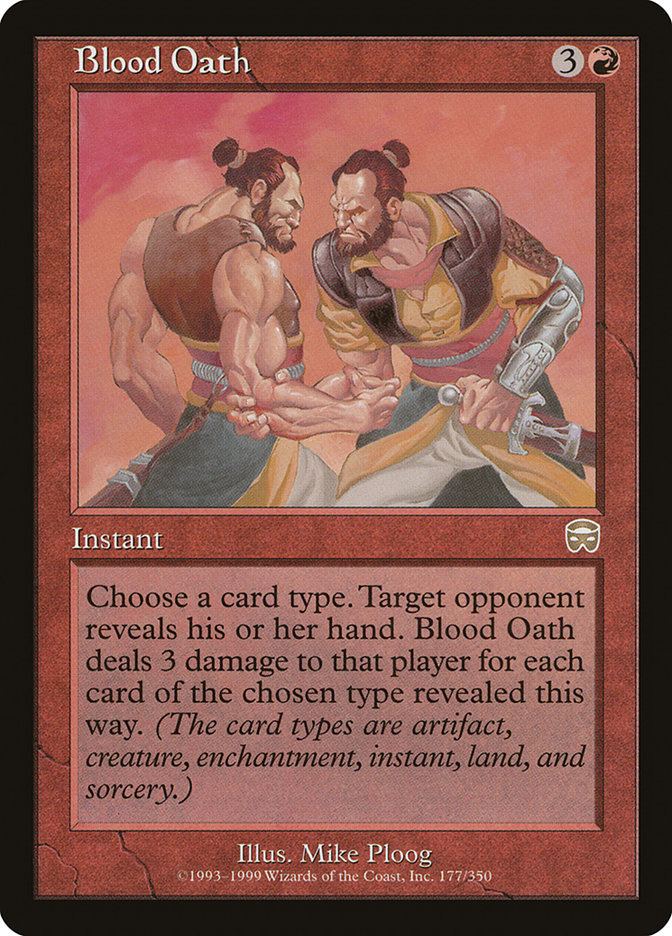 My tournament in Toronto did not go well. Anticipating a field full of what would now be known as Esper Control decks, I played a mono-red deck with four copies of Blood Oath in my maindeck to punish people for playing with Fact or Fiction. Neither my metagaming nor my draws worked out, and after a mediocre draft day I was essentially out of the running for money even with an undefeated finish on the last day.
My tournament in Toronto did not go well. Anticipating a field full of what would now be known as Esper Control decks, I played a mono-red deck with four copies of Blood Oath in my maindeck to punish people for playing with Fact or Fiction. Neither my metagaming nor my draws worked out, and after a mediocre draft day I was essentially out of the running for money even with an undefeated finish on the last day.
Rather than drop, I decided to make the most of my tournament experience. I had been planning on playing a Mono-Green Natural Order deck in the Extended portion already, so I decided to spice things up and have a bit more fun with it by putting both Rith the Awakener and Armadillo Cloak into my deck for the third day. I actually won a game by Armadillo Cloaking a Verdant Force against a Mono-Red deck. Suffice it to say he was displeased.
I ended up finishing out the last day of the tournament 5-1 and having an absolute blast while doing it. I even got featured in the coverage, and people at home seemed to love it too.
The Lesson: While tournaments are serious affairs, Magic is still a game and games should be fun. Sometimes you can turn a bad situation around just by changing the way you approach it.
2002 – Sydney (11th)
I prepared for Sydney as part of what was at the time referred to as the “Mini-Colony,” staying at Eric Froehlich’s house in Virginia for several weeks prior to the event to test. It had a name because back then such focused and consolidated testing was quite unusual. Along with Ben Rubin and Eric Froehlich, we built a Living Wish-centric Naya deck for Standard, which in our testing had been absolutely demolishing the Psychatog decks that were popular at the time. The reality at the tournament wasn’t as pretty, and after a strong start we all ended the first day with middling records.
I managed to stage a comeback on the second day in draft, historically not my strongest format, setting me up for a run at Top Eight in Block Constructed. I rattled off four straight wins with Mono-Black Control and found myself playing for Top Eight against Carlos Romao. I was in a commanding position in the first game, with Cabal Coffers and Mirari in play against his U/G Threshold deck, when he played Bearscape. I had Haunting Echoes to empty his graveyard and neutralize his enchantment, but when I cast my spell I didn’t copy it with my Mirari, and he was able to counter it with Envelop and ride his Bearscape to victory. That mistake was the single biggest in my Magic career with almost as much as possible at stake.
The Lesson: Owning your mistakes is the only way to improve. In fact, I wrote an entire article about it back then, which you can still find online today here.
2003 – Berlin (81st)
The World Championships in Berlin was my first stint at being a full-time gamer. I’d graduated from college shortly before leaving for the Netherlands for another gamer colony-style preparation period, this time with the Dutch powerhouses of Jelger Weigersma, Frank Karsten, Jeroin Remie and Victor van der Broek.
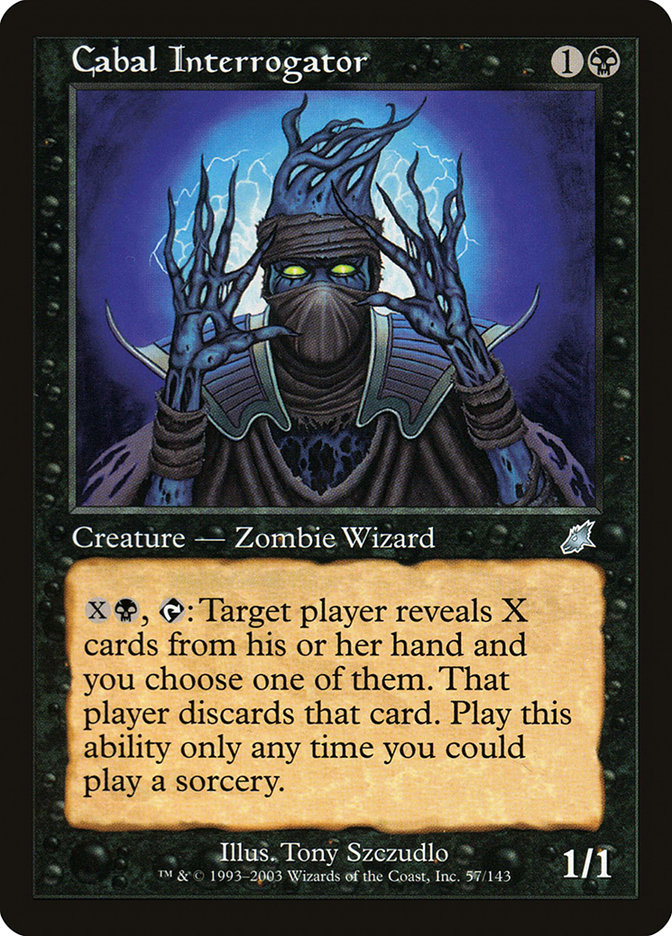 The most popular decks in Standard at the time were Mirari’s Wake, Goblins, and U/G Madness. I played a B/W Control deck largely based on the one Gabriel Nassif had played at the earlier European Championships. The deck was very strong against the creature decks, but it could struggle with Mirari’s Wake. In one of my favorite sideboard plans of all time, I played Cabal Interrogator alongside my maindeck Cabal Therapies to help pick apart the hands of the slow Wake decks.
The most popular decks in Standard at the time were Mirari’s Wake, Goblins, and U/G Madness. I played a B/W Control deck largely based on the one Gabriel Nassif had played at the earlier European Championships. The deck was very strong against the creature decks, but it could struggle with Mirari’s Wake. In one of my favorite sideboard plans of all time, I played Cabal Interrogator alongside my maindeck Cabal Therapies to help pick apart the hands of the slow Wake decks.
I did reasonably well in both of the Constructed formats, going 4-2 with both B/W in Standard and Reanimator in Extended. But like in many previous Worlds I stumbled in the draft portion, earning only two wins on the second day – which largely eliminated me from contention.
The Lesson: If you want do well in a multi-format event, you can’t ignore any of them. This is as true today as it was back then, but for a long time it was only Worlds and Nationals that split rounds between Constructed and Draft. I’ve always enjoyed Constructed more so I spend much more time preparing for it, and historically that has definitely cost me at the World Championships.
Oh, and another walk-down-memory-lane article I discovered while digging up old Worlds results. My first steps into the world of full-time pro gaming.
2004 – San Francisco (164th)
Worlds in 2004 was a strange event for me because I’d kind of mentally checked out of it well in advance. Over that same summer, I won the first VS System Pro Circuit tournament just after finishing second at Grand Prix New Jersey. After that, I found myself spending far more of my time playing online poker while staying with William Jensen and Brock Parker at their apartment in Maryland. For some reason I just didn’t have the same fire I’d had over the past year or so.
Part of it, I think, was that my VS System win sated some of my desire for a championship title. While it wasn’t a Magic Pro Tour win, which I’d wanted for so long, it was similar in kind. I think living the full-time gamer lifestyle that I had been for the previous year just wasn’t as appealing as it had been before, and I couldn’t bring myself to care enough to really put the same kind of effort as I once had.
My results in the tournament itself were certainly reflected in my mindset. I played mediocre decks and did poorly.
It would be one of my last major events for a long time. In early 2005 I moved to California to take a game design job at Upper Deck working on VS System.
The Lesson: Pro gaming isn’t always the dream job it sounds like it would be. It can be stressful, isolating, and at times entirely unfulfilling. The only reason to play games for a living is if you love it. A big part of my disillusionment with what I was doing at the time, in retrospect, came from my foray into online poker since making a living playing Magic alone wasn’t realistic back then. Nowadays, between a far greater number of independent tournaments with big prizes like the Open Series and a much higher demand for Magic content, it’s a different world. But back then, most pro Magic players were actually pro poker players, which I just never really enjoyed, so I left to do something I did enjoy.
Until I came back, of course. Because no one really quits.
2009 – Rome (166th)
Rome was my first international tournament back after returning to the Pro Tour. After five years away, I requalified through a PTQ, made Top Eight at my first event back in Honolulu, and then won PT Austin. Not a bad comeback at all! I even made Top Eight of the Grand Prix in Minneapolis the weekend before Worlds in Rome, which in a way was both a blessing and a curse. A blessing, of course, because it’s great to do well in any tournament – but a curse because it meant I was there playing in it in the first place!
After so long away, I’d completely forgotten the impact of jetlag on my ability to compete. I’d flown out of Minneapolis on Monday, putting me in Rome something like Wednesday morning local time for a tournament that started on Thursday. Despite the Red Bull promoters handing out free drinks in the lobby, of which I partook far more than my fair share, my brain simply couldn’t handle the time adjustment that quickly and I played absolutely terribly all weekend. I lost multiple games to simply playing the wrong fetchland in my Zoo deck on the first turn… after winning the Pro Tour with Zoo just a couple months before.
The Lesson: Understand and respect your body and mind’s needs and how they change as time goes on. Magic is a hard enough game when you’re awake and fully coherent; to play it when you’re jetlagged and sleep deprived is starting with an incredible disadvantage. And while I may have stayed up almost all night before each day of the Pro Tour in Chicago when I made my first Top Eight, that was back when I was twenty years old. Things don’t work that way anymore.
I actually put this lesson to almost immediate use, by the way, by traveling to the next Pro Tour in Amsterdam a week in advance to test there. I finished that tournament in the Top Eight, which was literally the first time I’d made money at a European event since my very first Worlds all the way back in 2000.
2010 – Chiba (78th)
Worlds in Chiba was a tournament of incredible highs and lows for me. I started the event 6-0 in the Standard portion with Caw-Go after my induction into the Hall of Fame, extending my lifetime record at Pro Tours while wearing a suit to 14-0 where it still stands today. I crushed my first draft pod, putting me solidly first in the standings at 9-0 before falling to a more realistic but still field-pacing 10-2 by the end of the second day.
And that’s when the wheels came off. I’d put so much of my focus on preparing for draft and Standard that I wasn’t happy with any Extended decks, and at the last minute I picked up the Five-Color Control deck the rest of the team was planning to play. I hadn’t practiced it and I wasn’t comfortable with it, but I didn’t feel like I had any idea what else to play.
I did not win a match that day. I dropped from the top of the standings to ultimately finish out of the money entirely after going 0-5-1. It was an absolutely crushing defeat, especially coming from the hopes after my initial run that I would be the first-ever player to make Top Eight at the event at which they were inducted into the Hall of Fame.
The Lesson: No, really – you can’t ignore any format of a multi-format tournament. If you do, it will crush your soul someday.
2011 – San Francisco (54th)
The final old-style Worlds took place at the same venue as the last one I’d played before my hiatus many years before, which seemed oddly appropriate. After spending a lot of time trying to get a U/R Delver deck to work, I broke down and ultimately played the same Tempered Steel deck as the rest of my team because it just seemed too good to ignore.
I ended up putting up decent but unspectacular results in each of the formats, the best of which was a 5-1 result with Tempered Steel in Standard, ending up with similarly decent but unspectacular finish. The rest of the team killed it, however, putting four members into the Top Eight in one of the most dominating performances by any team in history.
The Lesson: Preparation is the key to success, and teams are the key to preparation in modern-day Magic.
2012 – Seattle (6th)
The first of the new-format World Championships was held at PAX, much like this year’s event. My preparation for the event was a bit unusual because so much of the field was made up of members of my usual testing team. With such a small field it felt like working together with so many people didn’t make a lot of sense, so we fragmented into smaller groups. I ultimately split off from the rest of them in order to work with Jon Finkel, with whom I’d been friends for many years.
After testing lots of Jon’s mediocre Storm decks and my bad Bant lists for Modern, we eventually settled on playing a U/W Control deck similar to that played by Tzu-Ching Kuo at the Magic World Cup earlier that summer. The deck performed well for us in testing against most of what we expected, but we significantly underestimated the amount of Zoo that would show up at the event.
I ended up losing multiple rounds simply due to my Spell Snares and Remands being too slow to interact with my opponent’s Kird Apes. Thankfully, I put up excellent results in both draft formats to remain in contention heading into the final rounds of Modern, but I lost twice – first to Jon in the mirror match and then to Yuuya in the final round while playing for a Top Four spot.
The Lesson: Never underestimate Zoo. Even the best players in the world like to beat down, especially when playing a reliable aggressive deck gives you more time to test for the other formats.
2013 – Amsterdam (6th)
The last World Championships I played in was two years ago in Amsterdam, and in a way it was sadly reminiscent of Chiba in 2010. I started the tournament 5-1 and tied for first place by the end of Day One after posting a 2-1 record in Modern Masters draft and then running the tables in Standard with G/R Aggro. I’d correctly anticipated the metagame to be full of essentially nothing but Jeskai and Jund, and my Domris, Hellriders, Thundermaw Hellkites, and sideboarded Burning Earths ripped them to shreds.
God, that deck was good. It went on to absolutely dominate Standard for months afterwards, but I only ever got to play three rounds with it. It just doesn’t seem fair.
I stumbled a bit in the M14 draft, going 1-2, but I was still very much live for Top Four going into Modern. And then, just like in Chiba, I failed to win a match in the final format.
This time it wasn’t about not preparing for the format – I had tested for Modern, but clearly my testing had not panned out. I had felt fairly certain that Birthing Pod and Scapeshift would be among the most popular decks in the format, and I had been scared off of playing my traditional Naya with Knight of the Reliquary by the printing of Scavenging Ooze to eat all of the lands in my graveyard. I ended up playing G/W Aether Vial, which – while a fine deck – simply played too many low-impact cards to match up against good players with strong fair decks like Jund or Jeskai. I had hoped that my Voice of Resurgences and flash creatures plus Aether Vials would be good enough to beat removal-heavy decks, but my opponents had answers like Hallowed Burial and Gideon Jura to buy enough time to take over the game.
It was a painful result, but one in a way I felt like I deserved. I read too much into a metagame that I really didn’t know nearly enough about, and I got punished for it.
The Lesson: Solid, powerful, and proactive decks are almost always better than more fragile, fundamentally weaker “metagame calls.” Oh, and don’t let anyone scare you away from playing Knight of the Reliquary. That card is great.
Looking back over all these years is a good reminder that some of these are lessons I could still learn something from today. As the saying goes, if we do not learn from the lessons of the past, we are doomed to repeat them. Here’s to hoping I get another shot at the Magic World Championships to see if I’ve really learned anything after all these years!
I will be at PAX this year, even if I won’t be playing in Worlds. I’m sure I’ll be stopping by the Magic area, especially for the Battle for Zendikar reveal and the party. If you see me there, be sure to say hi!


